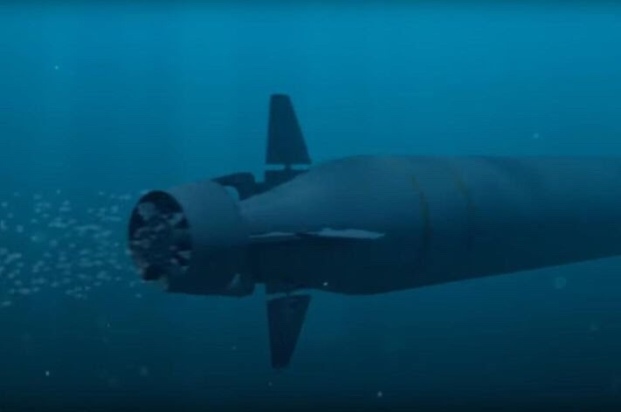
Graphic of Poseidon Intercontinental Nuclear-Powered Nuclear-Armed Autonomous Torpedo.
Russian Defense Ministry
Russia Testing Nuclear-Powered Mega-Torpedo Near Where Deadly Explosion Occurred
Aug 17, 2019,
Details are still emerging of the explosion of a nuclear-powered engine that killed at least seven people in northern Russia last week. Conflicting reports, rumors and speculation center around whether the engine was for a nuclear-powered cruise missile, codenamed Skyfall by NATO, or some other weapon-related reactor. One of the possible weapons in the frame is the Poseidon mega-torpedo. This new weapon is described as an Intercontinental Nuclear-Powered Nuclear-Armed Autonomous Torpedo by the U.S. government.
The unique drone-like weapon is in an entirely new category. Launched from a large submarine, potentially from under the protection of the arctic ice cap, it would have virtually unlimited range and Russia claims that it will run so deep that it cannot realistically be countered with existing weapons. It’s designed to be armed with a nuclear warhead, reportedly of 2 megatons, which represents a slow but unstoppable death-knell for the residents of coastal cities such as New York or San Francisco in the event of a nuclear war. The Russian Ministry of Defense also claims that it will be usable against high value maritime targets such as the U.S. Navy’s carrier battle groups.
It is massive, around 30 times larger than the heavyweight torpedoes commonly used aboard submarines, and twice as large as submarine launched ballistic missiles (SLBMs). Specially constructed submarines will be able to carry six Poseidon each. Unlike existing missile submarines, which are termed SSBNs, this type of submarine doesn’t even have a designation yet. Possibly SSDN will be used to denote a nuclear powered drone-carrying submarine.
Poseidon is being tested in the region, my analysis of information gathered from public sources shows. For trials it is being launched by a special submarine based in Severodvinsk, near the Nyonoksa testing site where the explosion occurred. The submarine is named Sarov after the city where the All-Russian Scientific Research Institute of Experimental Physics, which developed the nuclear engine involved in the explosion, is based. Sarov is also the city where the victims of the blast were laid to rest. In recent years the Russian Ministry of Defense has been open about Sarov’s role in the tests. The submarine rarely puts to sea but my analysis of information gathered from public sources shows that it did venture out into the White Sea in June, pointing to possible recent test launches.
Poseidon was first revealed to the public in dramatic fashion by Russian state media in the fall of 2015, when a slide on the new weapon was visible during a meeting with President Putin. The apparent security lapse was probably not by accident.
The project itself has since been traced back much further to the end of the Cold War, and defense watchers had an inkling of a giant torpedo-like weapon under development for about five years prior to the staged leak.
The weapon has been in testing since around 2014 and is likely to be nearing the production phase with deployments at sea from the early 2020s. The first submarine slated to carry the weapon operationally was launched in April in Severodvinsk. The gigantic Belgorod submarine is still undergoing fitting out and will not be operational for a few years. The second submarine, Khabarovsk, is also nearing completion and two more SSDNs are expected to follow, providing Russia with a new dimension in nuclear deterrence.
No comments:
Post a Comment